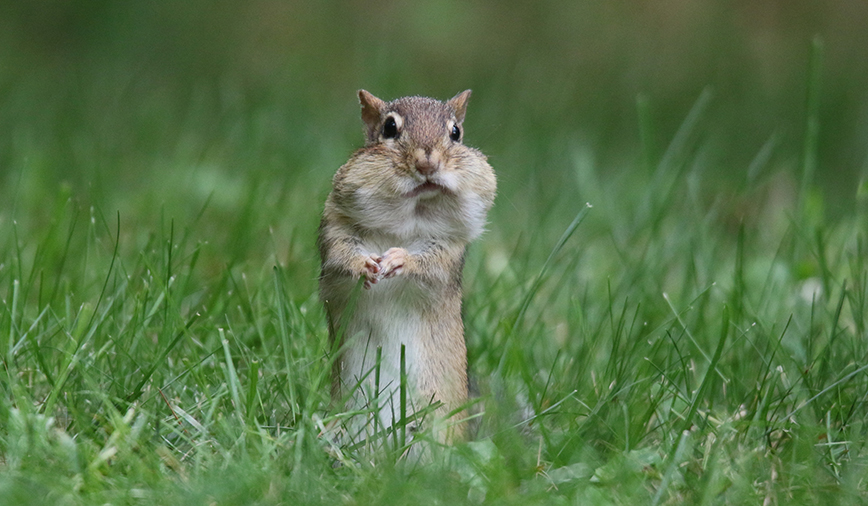Even though the corn and soybeans are still green in the field, some local harvests have already begun. Need proof? Just check out the chipmunks.
For some time now these industrious rodents have been taking advantage of the season’s bounty of ripe fruits and seeds. But then again, they take advantage of the bounty of three out of our four seasons. It’s what they’re built to do.
Equipped with two fur-lined cheek pouches—the chipmunk equivalent of shopping baskets—these little guys gather goodies like there’s no tomorrow. Black cherry seeds, maple seeds and tiny pine nuts are current favorites. And those of you with birdfeeders can probably attest to chipmunks’ love of sunflower seeds; chippies slurp up these oil-rich delicacies with vacuum cleaner-like efficiency.
Speed is important for chipmunks, since they must try to eat without being eaten. Small but meaty, they rank high on the menus of many local predators, including hawks and cats. Even so, a chip will pause during its gathering to nip the points off of seeds it deems too sharp, in order to protect the inside of the pouches. (FYI, I do something similar with pointy tortilla chips. Why risk a painful cut if a little prevention is all it takes?)
Although chipmunks may eat some food items on site—especially wet or juicy morsels—many more are transported back to the home burrow inside the animal’s cheek pouches. Once safely underground, the chipmunk empties its pouches in one of the burrow’s various “pantry” chambers. Some food items may be eaten immediately, some are saved for rainy days, and the rest are kept for the winter that is sure to come.
So well known is this hoarding instinct that it is reflected in our Eastern chipmunk’s scientific name. The genus name Tamias is from the Greek for “treasurer or storer.” In fact, pioneers and Native Americans used to dig up chipmunk burrows to gain access to the rich larder below.
Unlike some of those folks you see on Oprah and Dr. Phil, chipmunks don’t hoard just for hoarding’s sake. No, for chipmunks, hoarding is the key to winter survival.
Unlike their cousins the woodchucks (a.k.a. groundhogs), who put on prodigious amounts of fat in fall and then hibernate through the winter, chipmunks pass the cold-weather months in varying states of torpor. They sleep a while, wake up, eat, make a trip to the restroom chamber, then curl up and snooze some more.
Woe to the chipmunk whose winter stores are inadequate. Foraging in winter is risky business for these small rodents, since they lack the warm coats and extra fat that their relatives the gray and fox squirrels grow. Nonetheless, a warm winter day may coax a chipmunk to come up above ground for a brief time, perhaps for a stretch and a drink; then it’s back down below to await the coming of spring.
Although chipmunks are noted for their food-storing habits, their underground burrows are quite remarkable too. Ranging up to 30 feet in length, these subterranean hideaways typically start off as a tunnel that goes straight down for a distance of about six inches, then turns off at an angle and slopes downward to a depth of three feet or more.
The burrow usually has one “front door,” with several “emergency exits” in case a predator comes calling. The main entrance measures about 1 ½ to 2 inches across and, while conspicuous in the way that 2-inch holes can be, it is inconspicuous in that it lacks a pile of dirt next to it. Chipmunks always take care to distribute the dirt they excavate so as to not call attention to their humble abode.
A complex burrow system, instinct-driven hoarding behavior, and built-in cheek pouches. What more could you ask for in a rodent? Next time you’re out and about, be sure to take some time to check out the chipmunks.
Pam Otto is the manager of nature programs and interpretive services for the St. Charles Park District and can be reached at potto@stcparks.org or 630-513-4346.

